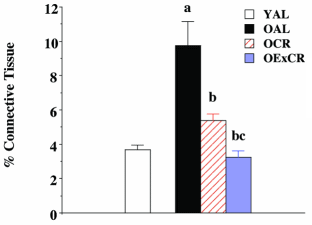|
Definition: "An ergogenic aid is any substance or phenomenon that enhances performance "
|
|
||||||||
19.12.2009 |
|
|
Training and a bit of a diet together keep ageing muscles strong
If you're planning on living to a hundred and you want to retain your muscle mass without using hormone therapy, then according to the scientific literature, there's only one way that may work: by going continuously hungry. In other words: calorie restriction. But health scientists at Texas A&M University have found an alternative way which makes life a lot pleasanter. It works in lab rats.
In Experimental Gerontology the researchers describe a study in which they compared 4 groups of male rats: control animals that were not physically active, were allowed to eat as much as they wanted and were 6 months old. [YAL] In human terms a 6-month-old rat is in its twenties.
A second control group did the same as the first control group, but were 2 years old. [OAL] That's ancient for a lab rat.
The first experimental group got a slightly calorie restricted diet for their entire life. [OCR] The animals ate 8 percent fewer joules than they needed. At that level your bodily functions remain intact. The researchers studied the animals when they were 2 years old.
The figure below shows that the combination of a slightly calorie-restricted diet and physical exercise protected muscle mass. The figure below reflects the ratio between the weight of the plantaris calf muscle and total bodyweight.
Muscles degenerate as they age. If you look at them under a microscope, you'll see that holes start to appear in the muscle tissue. They start to unravel like the sleeves of an old sweater. The figure below shows how physical exercise prevent the extra myocyte spaces from getting bigger.
Muscle cells disappear in ageing muscle tissue and the space is filled up by connective tissue cells. More and more muscle tissue is actually no longer muscle tissue. This process is stopped by physical exercise, and a combination of physical exercise and diet works even better.
How these effects work the researchers are not sure. Diet and training had minimal effects on the production of endogenous antioxidants like superoxide-dismutase. The effects were negligible. The researchers did discover that a combination of diet and training did prevent a reduction in the production of the anabolic hormone IGF-1 to a large extent.
The researchers should really have also had a group of rats that were allowed to run on a treadmill, but that could also eat as much as they want. The reason that this group did not figure in the study is that you can't get lab rats that are older than six months to run. Only if you give them less feed will they become physically active.
The Americans suspect that the same is true of humans. "These findings provide direct evidence supporting the notion that long-term primary prevention strategies in adults to address age-induced sarcopenia should include lifelong mild caloric restriction and daily, continuous voluntary exercise."
Source:
More:
|
|





